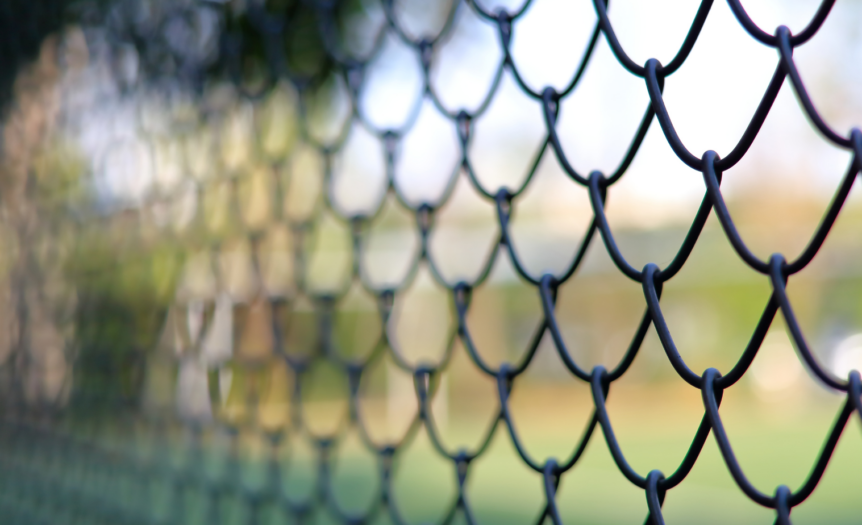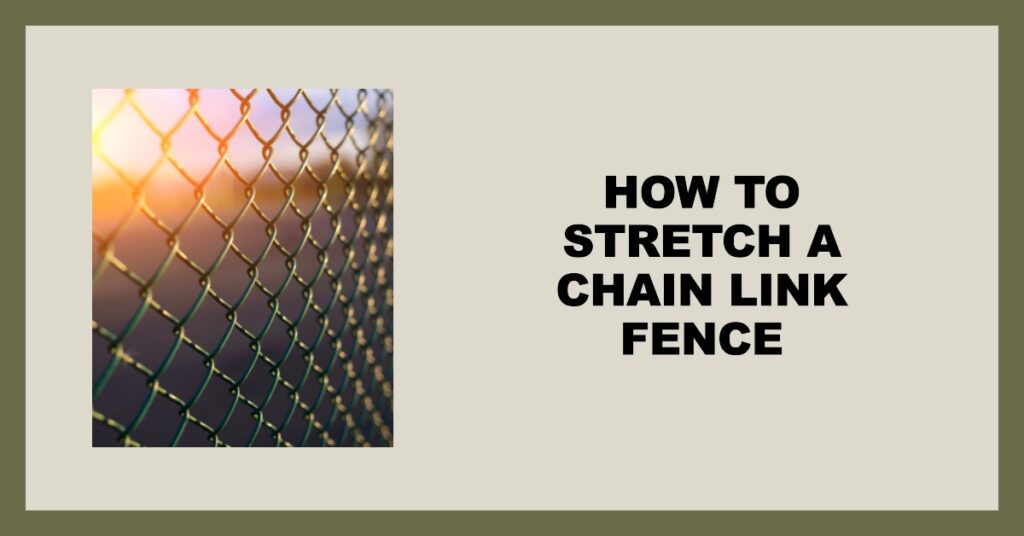A well-maintained chain link fence can be both an attractive and functional addition to your property. However, over time, it may lose its tightness and require stretching to regain its original appearance and effectiveness.
In this comprehensive guide on how to stretch a chain link fence, we’ll break down the essential tools, materials, and techniques needed for this task while providing you with step-by-step instructions for performing the job efficiently.
Understanding Chain Link Fences And Reasons To Stretch Them
A chain link fence is made up of several components, including the fabric, posts, rails, tension wire, and fittings. Stretching a chain link fence can help ensure it remains secure and straight over time.
It can also improve its appearance and increase the longevity of the materials used.
Vocabulary And Components Of A Chain Link Fence
Understanding the various components and vocabulary of a chain link fence is crucial before taking on the task of stretching it.
A few other important terms you might encounter when dealing with chain link fences are selvage – referring to how top and bottom edges are finished (such as knuckle-knuckled or twisted); gauge – indicating wire thickness with higher numbers meaning thinner wires; diamond mesh size – measuring diagonal opening dimensions in inches; cyclone fencing – another name for chain-link material often used interchangeably.
Benefits Of Stretching A Chain Link Fence
Stretching a chain link fence comes with numerous benefits to your property. One of the most prominent advantages is an improved aesthetic appeal.
Another benefit of stretching a chain link fence is increased security. When the fabric is stretched tightly, it creates less room for intruders or animals to squeeze through or climb over the fence.
Stretching also ensures the longevity of your fencing materials since there’ll be minimal movement caused by wind and other environmental factors that could cause rapid wear and tear on your fence parts.
Overall, stretching a chain link fence not only improves its functionality but also its overall look while adding value to your property.
Factors To Think About Before Stretching A Chain Link Fence
Before stretching a chain link fence, there are several factors to consider that can impact the success of your project. One crucial consideration is the age and condition of your current fence.
Another important aspect to think about before starting a project like this is the size and layout of your property. You’ll need enough space around the perimeter of your fence to properly install and employ a tensioning system for stretching purposes.
Finally, if you’re not comfortable with tools or have limited experience working on fences or home improvement projects, it may be best to hire a professional rather than attempting to do it yourself.
Tools, Techniques, And Materials For Stretching Chain Link Fences
To stretch a chain link fence, you’ll need specific tools and materials such as tension wire, bands, turnbuckles/ratchets and a fence stretcher tool; however, the techniques vary based on the existing layout of your property.
Fence Stretcher Tool Options
There are several options for fence stretcher tools that can be used to stretch a chain link fence. One of the most popular is the comealong tool, which uses a lever and ratchet system to pull the fence fabric taut.
Another option is a fence stretcher bar, which is inserted into the end of the fabric and tightened with tension bars or bands.
Some other tools that can be helpful in stretching a chain link fence include cyclone fencing pliers, which can be used to straighten out any kinks or bends in the wire, and ratchet straps, which can help secure the fence in place as it’s being stretched.
Overall, choosing the right tool for stretching your chain link fence will largely depend on factors such as how much tension you need to achieve and how many posts you have along your property line.
Tension Wire, Bands, And Turnbuckles/Ratchets
In order to stretch a chain link fence properly, you’ll need tension wire or bands and turnbuckles/ratchets. These items help create the necessary tension needed to straighten out any kinks in your fence line.
Tension wire is installed horizontally along the top and bottom of the fence and provides stability to prevent sagging.
It’s important to ensure that these materials are installed properly in conjunction with a fence stretcher tool. Without sufficient tension, your chain link fence won’t be able to withstand harsh weather conditions or pressure from animals or humans leaning on it.
Additional Materials Needed
In addition to a fence stretcher tool and tension wires, bands, and turnbuckles/ratchets, there are a few other materials you’ll need when stretching your chain link fence.
First on the list is some heavy-duty gloves to protect your hands from any injuries while handling rough or sharp components of the fence.
Next up is a good set of pliers for securing wire ties that connect the fence fabric to terminal posts. A tape measure comes in handy for ensuring accurate post spacing during installation and placement of tension wires along the top and bottom edges of the fabric.
In summary, stretching a chain link fence isn’t just about having the right tools – it’s also important to have appropriate protective gear and accuracy-measuring instruments on hand.
Step-by-Step Guide On How To Stretch A Chain Link Fence
To stretch a chain link fence, start by preparing the fence and surrounding area, then installing tension wire, bands, and turnbuckles or ratchets. Next, use a fence stretcher tool to pull the fabric tight and adjust it as needed before securing the fence in place.
It’s important to work slowly and in small sections while verifying that the fence is level and straight.
Preparing The Fence And Area
Before starting to stretch a chain link fence, it’s important to prepare both the fence and the surrounding area. Begin by assessing the condition of your existing fence fabric, posts, rails, and other hardware to ensure they are in good working order.
Next, clear any obstructions or debris from around your fence line that could interfere with your work area or cause damage during the stretching process.
It’s also essential to check local regulations and property lines before installing or stretching a chain link fence on private land. Be mindful of underground utilities and make sure you have obtained any necessary permits before beginning your project.
Installing Tension Wire, Bands, And Turnbuckle/Ratchet
To properly stretch a chain link fence, tension wire or bands and turnbuckles/ratchets are essential components. Tension wire is typically installed at the top and bottom of the fence fabric to provide additional support and prevent sagging.
To install tension wire, first determine where it will be placed on the fence. Next, attach a band around the terminal post at that location and loosely wrap the tension wire around it in a figure-eight pattern.
Use pliers to twist together two ends of the tension wire near each end of your section until it’s taut but hasn’t pulled on either side yet.
When installing turnbuckles/ratchets, place them on either end of your desired section before looping in your tension wire through its hooks or clamps.
With these steps completed successfully, you’re ready to begin stretching your chain link fence!
Using A Fence Stretcher Tool
A fence stretcher tool is an essential piece of equipment when it comes to stretching your chain link fence. This tool allows you to apply uniform tension across the fabric, ensuring that it’s properly stretched and secured in place.
When using a fence stretcher tool, start by attaching it to the end post and then pulling the fabric taut while holding onto the handle of the stretcher. Once you have stretched the fabric enough using one section of your fence, move on to another section until all areas are evenly tight.
Finally, once you have finished stretching the fabric and securing everything into place with tie wires or ratchet straps make sure to double-check for any loose areas before finishing up.
Adjusting And Securing The Fence
Once the fabric is stretched, it’s important to adjust and secure the fence properly. Adjusting the tension wire or turnbuckle/ratchet may be necessary to ensure an even and taut fence.
Check for any sagging areas or loose connections between terminal posts and fence rails.
Next, secure your chain link fence by anchoring it firmly in place with concrete around each post base. This will prevent shifting from high winds while keeping kids and animals safely within your property lines.
Tips And Tricks For Stretching Chain Link Fences
To ensure your chain link fence is properly stretched and maintained, it’s important to work slowly and in small sections while also verifying the fence is level and straight.
Regular maintenance such as tightening tension wire or checking for damage can prevent further issues down the line.
Work Slowly And In Small Sections
When stretching a chain link fence, it’s essential to work slowly and in small sections. By doing so, you’ll reduce the risk of damaging the fence fabric, posts, or other materials that make up your property’s chain link fencing.
When working with a large section of fence, consider breaking it down into smaller parts and working on each individually.
For example, suppose you’re using a comealong tool to pull the fence tight. In that case, you’ll want to apply pressure gradually rather than all at once. Pulling too fast may cause your terminal post to shift or bend over time, which could compromise the strength of your entire fencing system.
Verify The Fence Is Level And Straight
It is crucial to ensure that your chain link fence is level and straight when stretching it. Otherwise, the fence might look lopsided or sag in specific areas. To verify if your fence is level and straight, use a measuring tape to measure the distance between the top of the terminal posts’ highest point and check that they are at an equal height.
You can also check for diagonal measurements on opposite corners to ensure that both distances are equal.
Once you have verified that everything is aligned correctly, double-check by examining the entire length of the fence fabric closely. If there are any kinks or twists along its length, adjust accordingly using additional tension wires, bands or turnbuckles/ratchets as necessary until everything looks perfectly aligned.
Perform Regular Maintenance
To ensure that your chain link fence remains in good condition, it’s essential to perform regular maintenance. This involves checking the tension of the fence fabric and adjusting it if necessary using a comealong tool or fence stretcher rental.
You should inspect your fence at least once per year for signs of wear and tear, such as rusted metal or torn fabric. If you notice any issues with your fence during this inspection, it’s best to address them promptly before they become more extensive problems requiring costly repairs.
Seek Professional Assistance If Needed
While stretching a chain link fence is something that most people can do on their own, there are certain cases where seeking professional assistance may be necessary. If you have a large property with extensive fencing or if you don’t feel confident in your ability to properly stretch the fence, it’s best to leave the job to experienced professionals.
Additionally, if you encounter any unexpected issues such as broken components or major flaws in your current fence system, a professional contractor will have the knowledge and tools required to address these problems.
Conclusion
Stretching a chain link fence is an important task that can improve your property’s security, privacy and aesthetic appeal.
Remember to assess the condition of your fence components beforehand and work slowly in small sections.
If you’re not comfortable doing this job yourself or don’t have access to specialized equipment like a fence stretcher tool, consider hiring a professional contractor or renting one from a local hardware store.
With these tips and tricks on how to stretch chain link fences, you’ll be able to enjoy all the benefits of a secure and attractive perimeter without breaking the bank.







